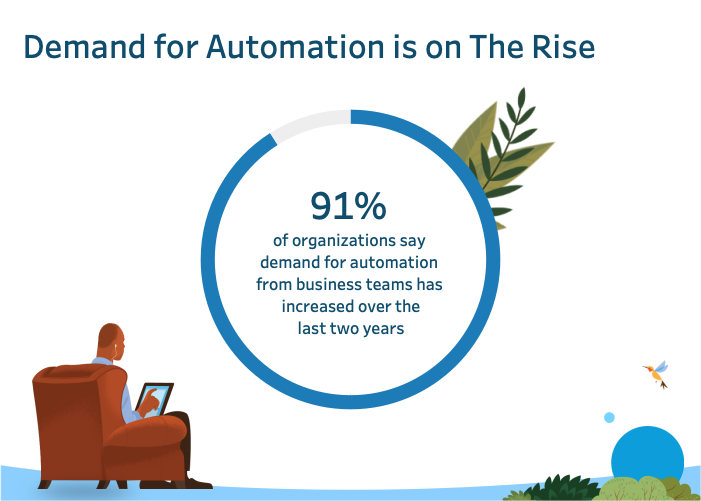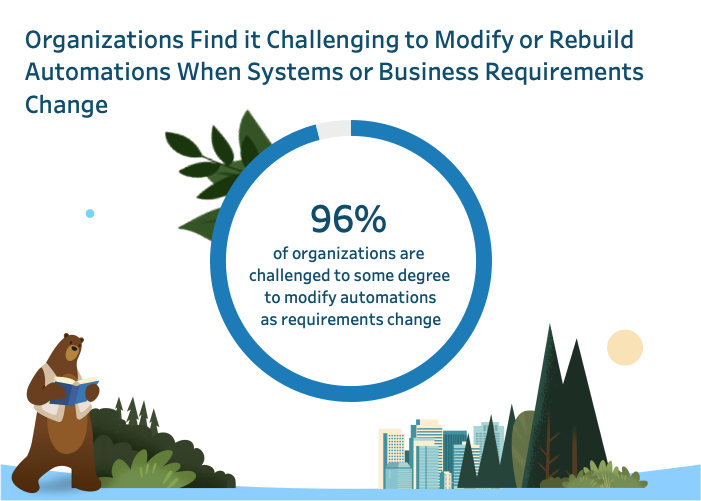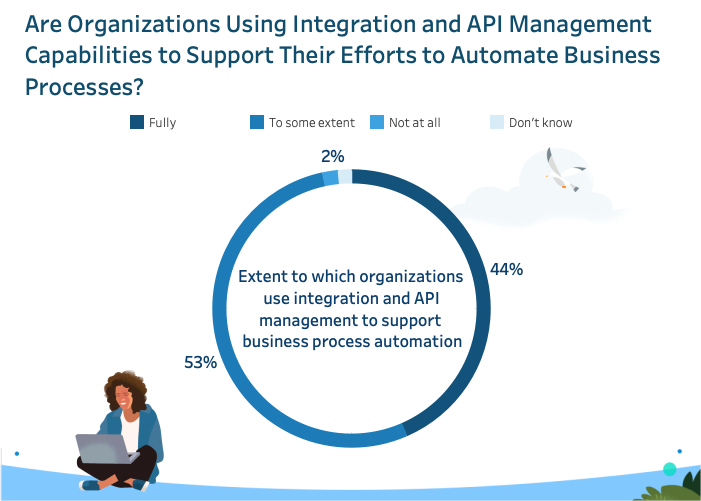Quick take: A new study from Salesforce and Vanson Bourne reveals business demand for automation has surged and now spans multiple departments in a bid to accelerate efficiency and productivity due to macroeconomic uncertainty. However, existing technology architectures are slowing progress, and 80% of organizations are concerned supporting automation is likely to compound technical debt. Automation done right can fuel efficient growth. By tapping into the combination of integration and API management, companies are successfully scaling automation and reaping the benefits.
With macroeconomic uncertainty — across markets, hiring, costs, and more — now firmly top of mind, CEOs and leaders across the business are focused on efficient growth, cost savings, and increased productivity. As a result, companies are turning to automation more than ever to drive immediate value across all parts of the business, from technical to non-technical departments like sales, customer service, marketing and commerce.
To understand how IT is approaching these demands and some of the challenges they face, Salesforce commissioned a global survey of 600 CIOs and IT decision makers.
Automation, yes (but not at any cost)

The vast majority (91%) of respondents report that demand for automation from business teams has increased over the last two years. Looking in more detail, the highest demand for automation came from four departments:
- Research and development (39%)
- Administrative/operations (38%)
- Customer service (33%)
- Marketing (26%)
The survey also reveals that existing technology stacks are impacting the speed at which IT teams are able to meet automation demands from the business.
Nearly all (96%) respondents said that modifying and rebuilding automations is a challenge as systems and business requirements change. In addition, 4 in 5 respondents said restructuring existing application and data landscapes to support automation would likely compound their organization’s technical debt.
“Organizations across every industry want to automate processes and customer experiences as quickly as possible. However, if they try to go fast with the wrong tools and techniques, they’ll actually impede true innovation,” said Matt McLarty, Global Field CTO & VP of the Digital Transformation Office, MuleSoft. “It’s vital that organizations become more adaptable to technological change, enabling them to build automations and connect data and applications in a holistic manner. Without taking a more composable approach, organizations risk compounding rather than reducing their technical debt.”

Automation done right fuels efficient growth
As organizations attempt to unlock the full potential of automation to not only fuel growth, but create efficient growth in a quicker and less disruptive way, nearly half (44%) are now using integration and API management capabilities to fully support their business process automation efforts. A further 53% stated they were using integration and API management capabilities to “some extent,” indicating that there is a massive opportunity to more efficiently automate workflows at scale and deliver connected customer experiences faster.
This comes as more organizations seek to orchestrate their use of multiple technologies, tools, and platforms to automate business and IT processes in a hyperautomation strategy.

The survey reveals that 80% of organizations will have hyperautomation on their technology roadmap within the next 24 months, meaning that they need the right tools and capabilities to build and modify automations.
“Organizations should never just think that once a process is automated the job is done,” said McLarty. “If we’ve learned anything through this volatile period, in fact, it is that we need a new mentality when it comes to business.”
Organizations should never just think that once a process is automated the job is done
With a new, more composable mentality, McLarty says that any organization can thrive.
“The organizations that thrive in the digital economy are the ones that adapt to changes the fastest,” continued McLarty. “For established companies, that means focusing on three things: growth with efficiency and sustainability, agility with safety at scale, and continuous innovation.”
Learn more
By taking a unified approach to integration, API management, and automation, companies will have a more resilient, secure, and flexible foundation to automate business processes in the future. MuleSoft enables hyperautomation by making it easy for business and IT users to integrate data from anywhere and automate business processes to increase efficiency and speed.
- Register and tune into MuleSoft CONNECT to learn how to unleash innovation.
- Discover Salesforce Customer 360 fueled by MuleSoft, Tableau, and Slack.
- Read about how integration, automation, and APIs work together to get any organization’s hyperautomation in motion.
Survey Methodology
Salesforce, in partnership with Vanson Bourne, surveyed 600 IT leaders from global enterprises. The online survey was conducted in February 2022 across the United States, the United Kingdom, France, Germany, and Australia. Only suitable candidates participated in the survey and were verified by using a rigorous, multi-level screening process. All respondents work at an enterprise organization in the public or private sector with at least 1,000 employees and hold a managerial position or above in an IT department.















